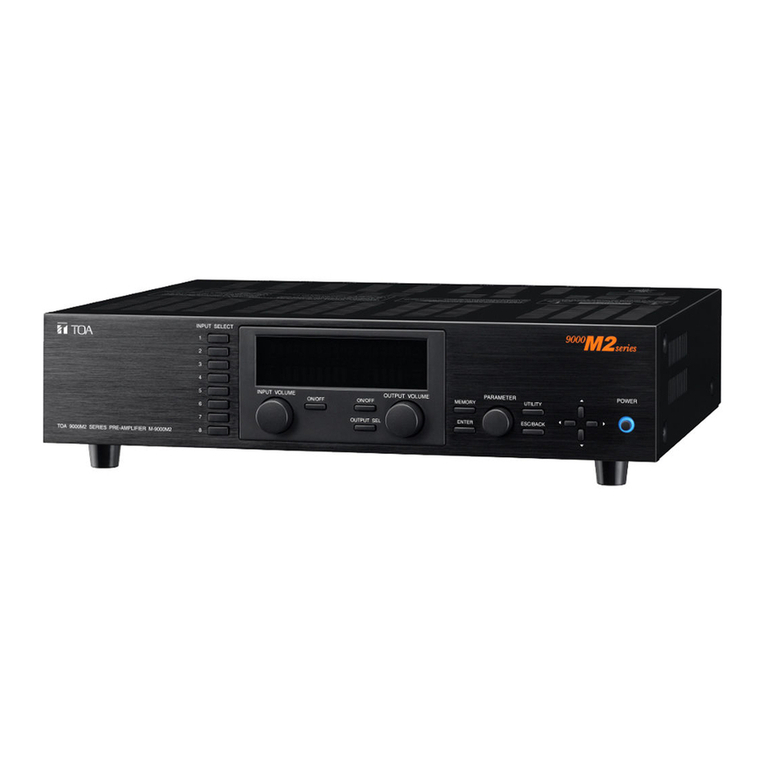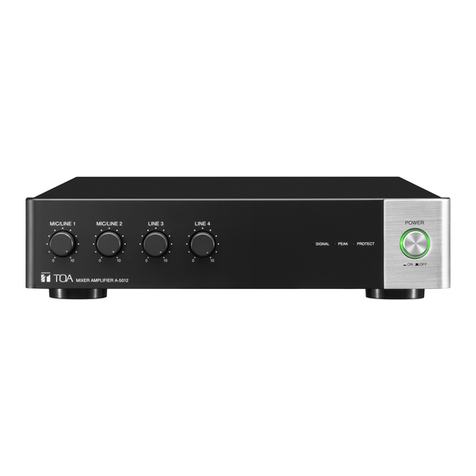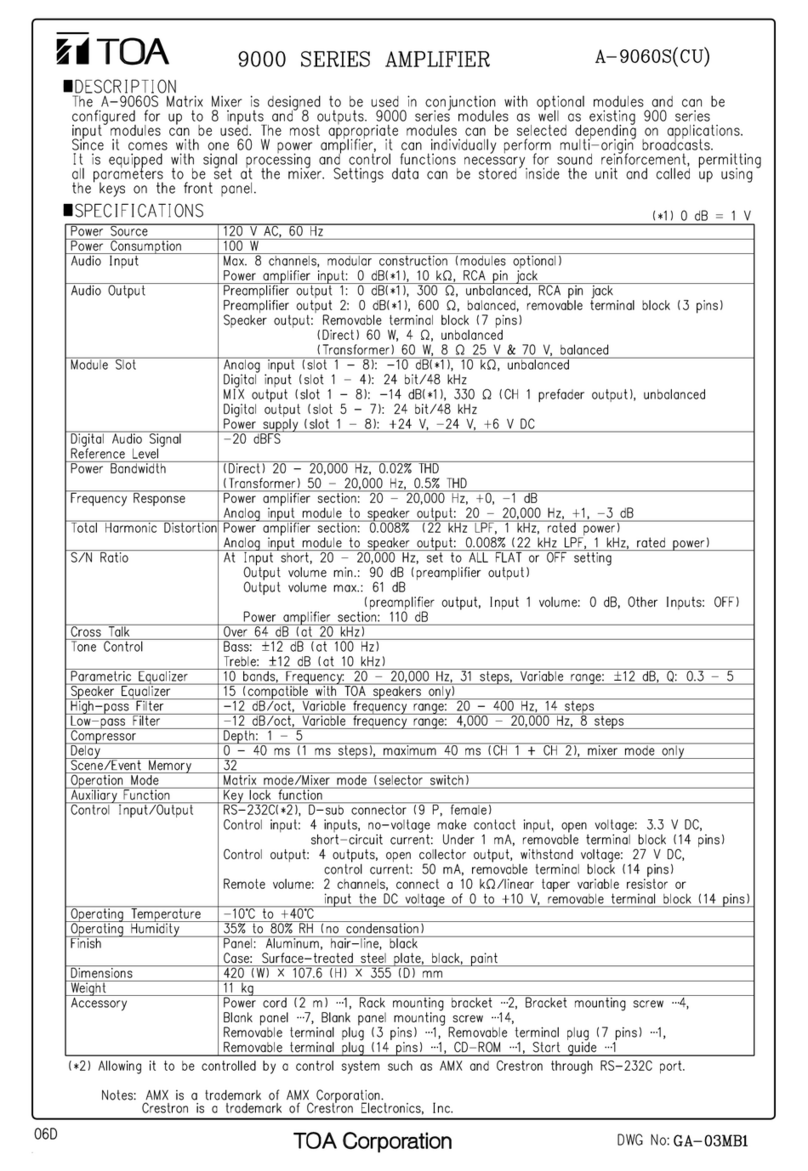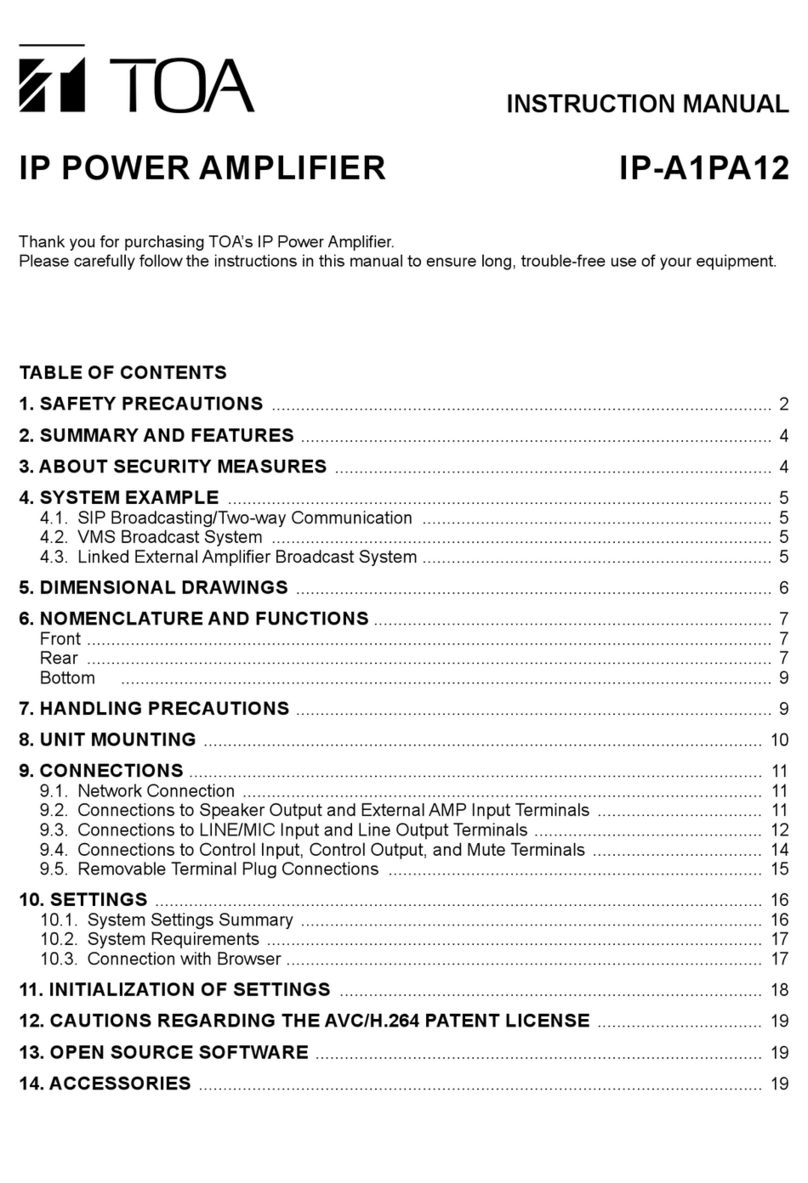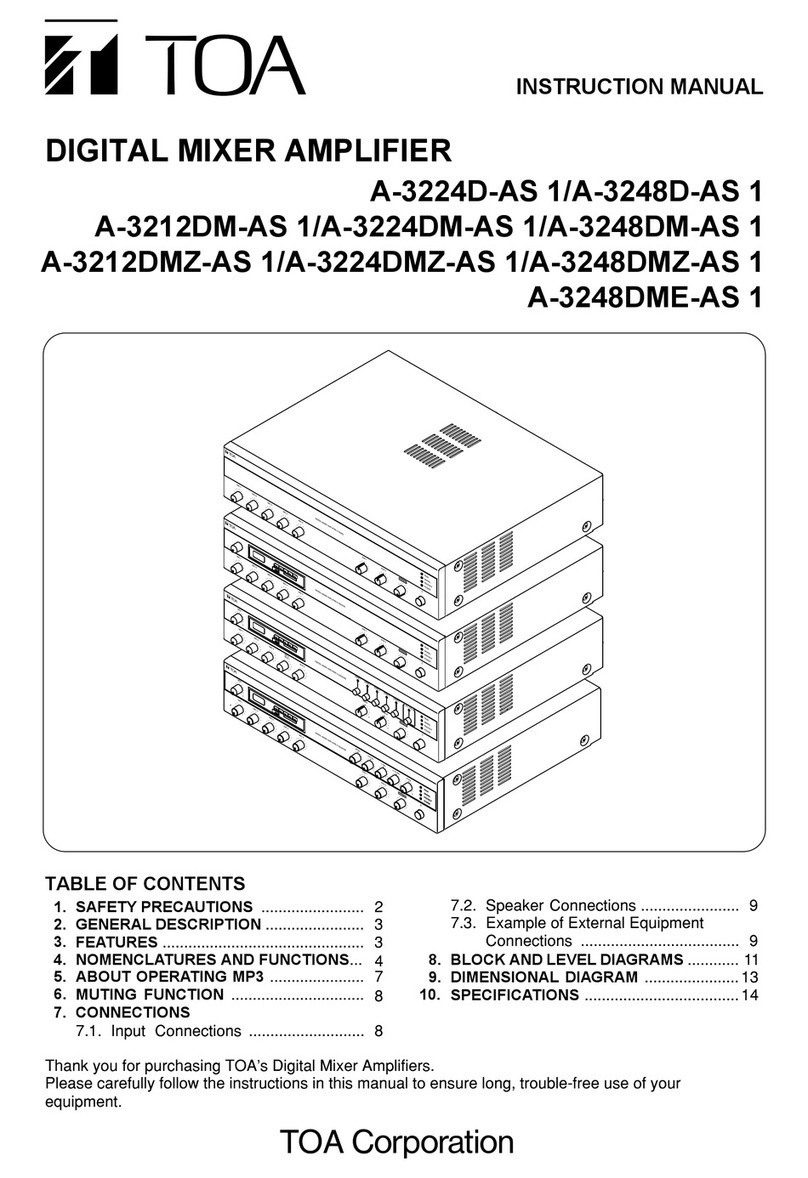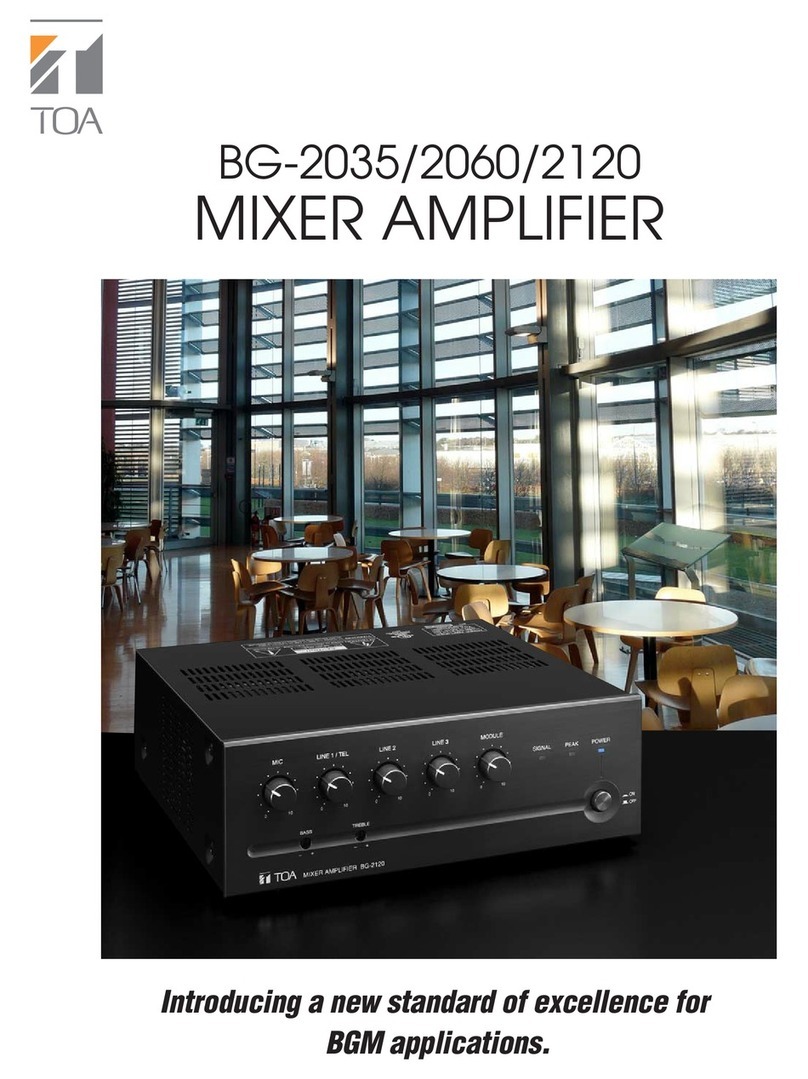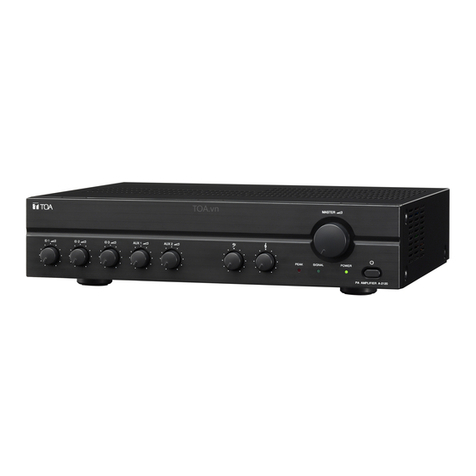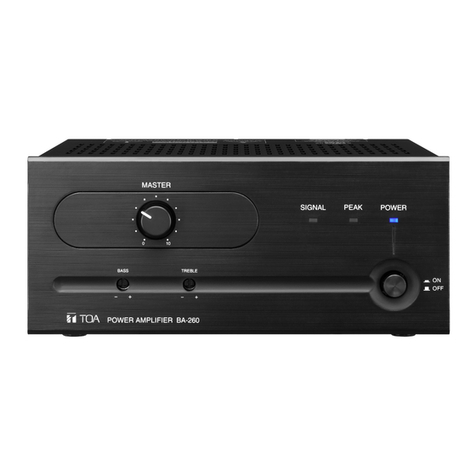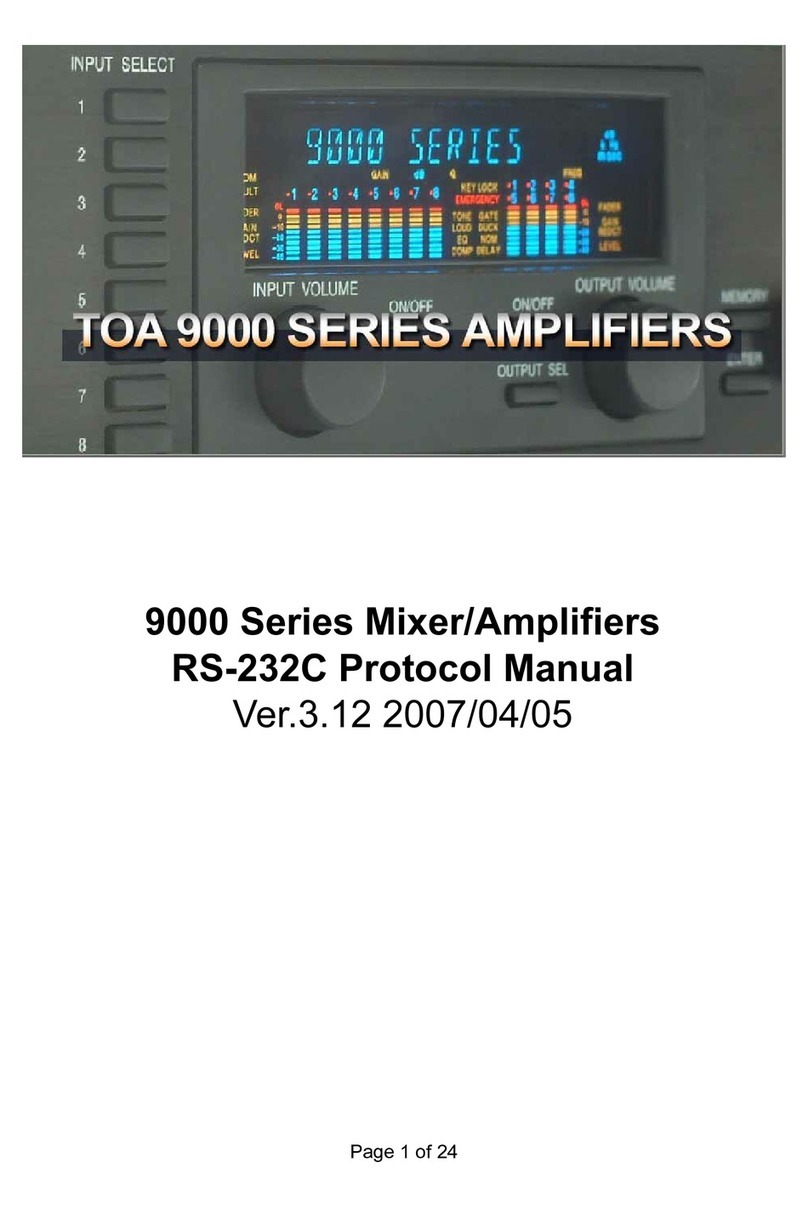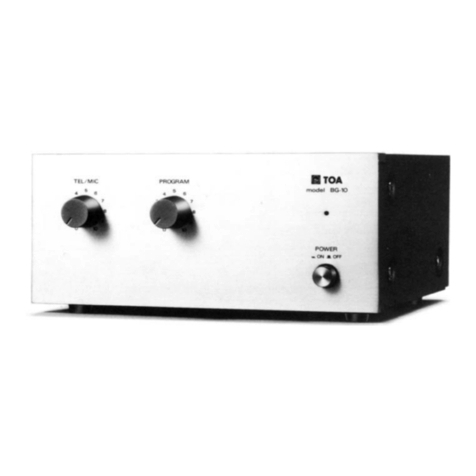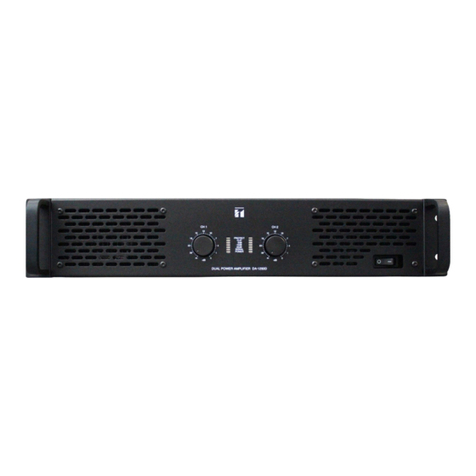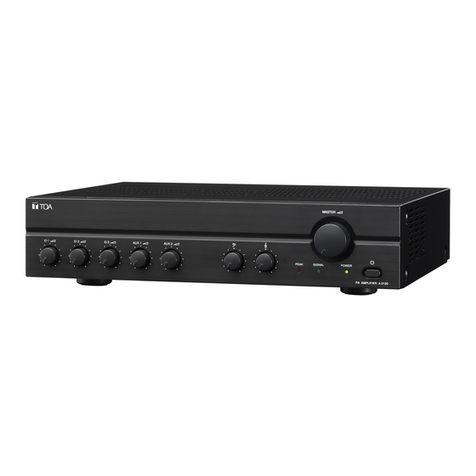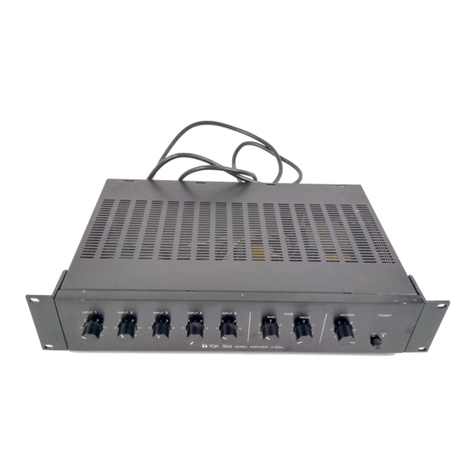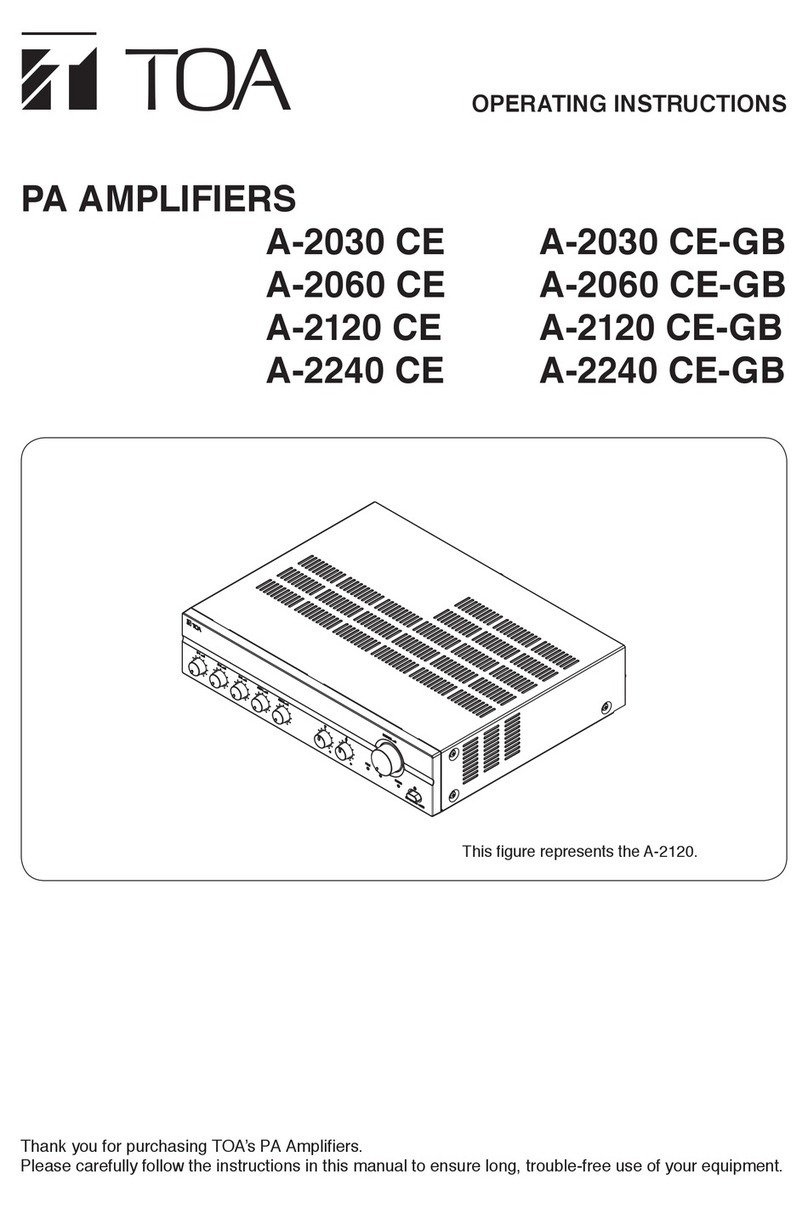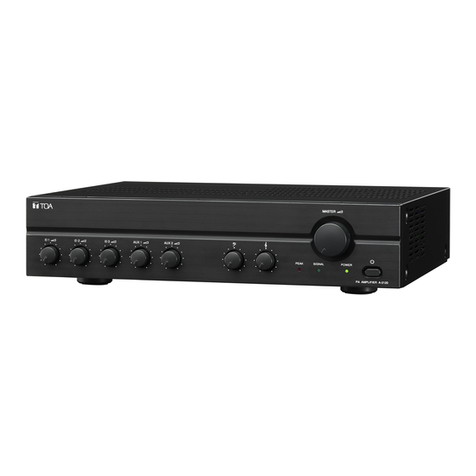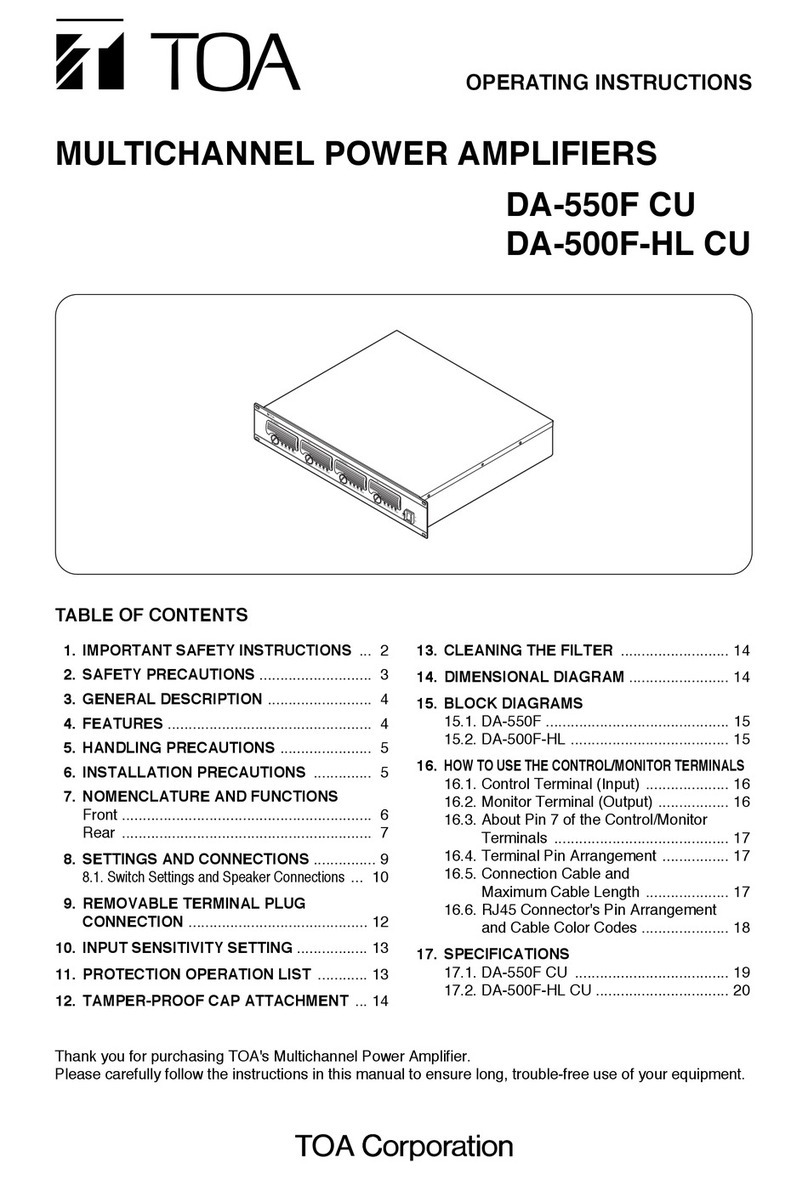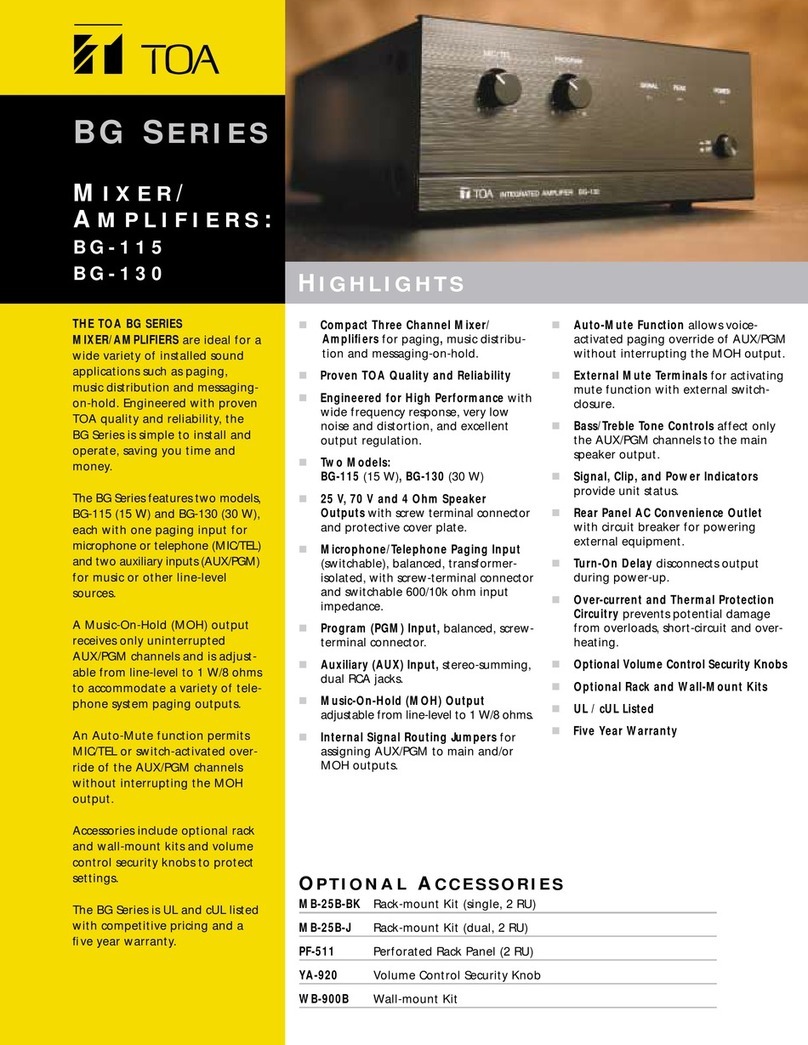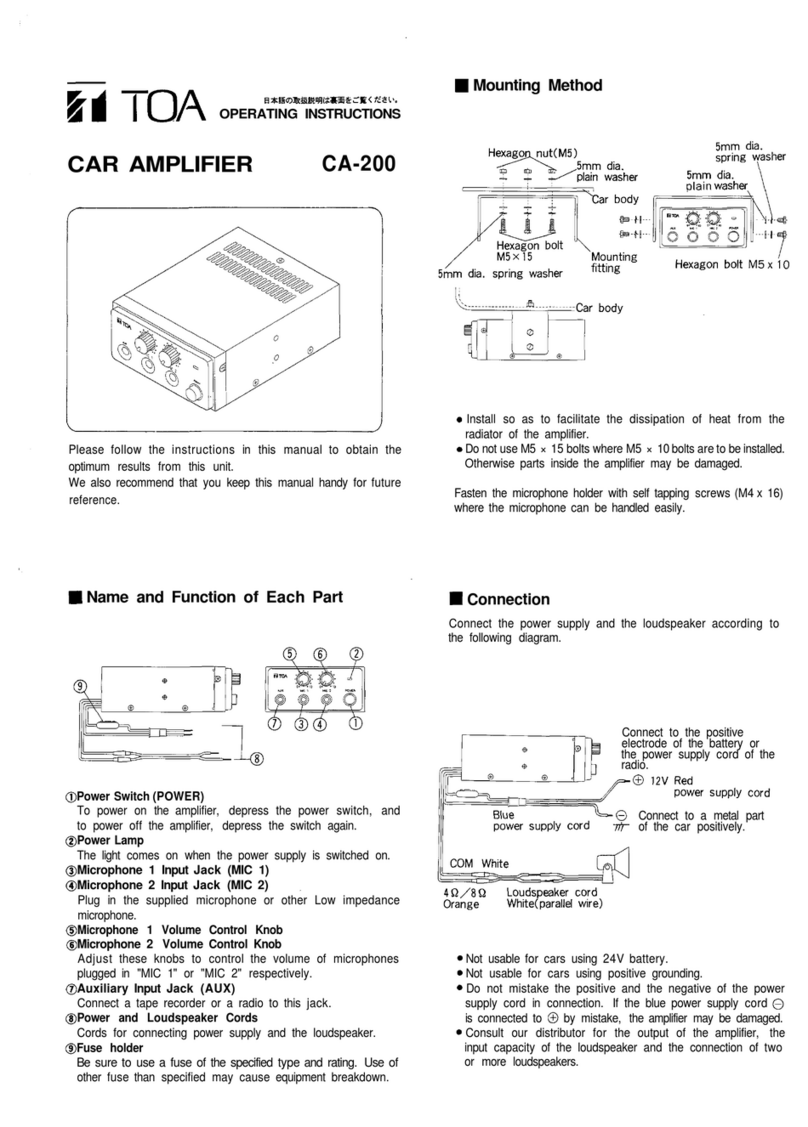Effe t Control [EFF]
This control determines the
amount of post-fader/post-EQ sig-
nal assigned to the effect buss
from a given input channel, and
thus the level of effects for that
channel.
Clip LED Indi ator [CLIP]
The LED indicator lights when
the pre or post EQ signal level
reaches 3dB below clipping, giv-
ing a visual reference for opti-
mum setting of the level control.
Under normal usage, the clip
LED's should only flash intermit-
tently. A constant or steady LED
indicates that the input level con-
trol setting is too high, and
should be reduced.
Low Equalize r Control [LOW]
The low EQ control alters the low
frequency response of the input
channel, providing ±15dB at
20Hz of continuously variable ac-
tive shelving equalization. The
"0" detented position provides
flat audio response. Please note
that excessive boosting of low
frequencies may cause the input
clip LED to light. Under these
circumstances, it may be neces-
sary to lower the input level
control in order to maintain prop-
er headroom and minimize dis-
tortion.
High Equalizer Control [HIGH]
The high EQ control alters the
high frequency response of the
input channel, providing ±15dB
at 20kHz of continuously variable
active shelving equalization. The
"0" detented position provides
flat audio response.
Balan e Control [BAL ]
This control adjusts the level ba-
lance of the channel input signal
fed to the Stereo Left and ight
mixing busses.
Input Channel Leve l [LEVEL]
The level control provides con-
tinuously variable adjustment of
the channel output to the Stereo
Left and ight mixing busses,
thus determining the level of the
channel in the main sound sys-
tem mix. The nominal level of the
input level control is at the "0"
dB position.
Graphi Equalizer In/Out Swit h
[IN/OUT ]
The in/out switch enables com-
parison between a flat response
(OUT) and the equalized re-
sponse (IN). The "out" position
completely removes the equalizer
from the KD-3 circuitry.
Graphi Equalizer Control
[GRAPHIC EQUALIZATION]
The graphic equalizer is 5 inde-
pendent active bands (filter), pro-
viding 15dB of boost or cut at
each center frequency. The "0"
detented position provides flat
audio response.
Internal Reverb Equalizer-
Control [ EV EQ HIGH/LOW]
These controls alter the frequency
response of the built-in reverb
circuitry. The "0" detented posi-
tion of both controls provide flat
audio response.
Cross-fade Control for Reverb
and Effe t [REV/EFF X-FD]
When this control is in the center
position, the reverb signal (thus
the internal reverberation unit)
and EFF ET signals are equally
assigned to the Stereo mixing
buss. otating the control
counter-clockwise decreases the
EFF ET signal level, keeping the
original level of the reverb signal.
otating the control clockwise
decreases the reverb signal level,
keeping the original level of the
EFF ET signal.
Level Control fo r Reverb/Effe t
[REV/EFF LEVEL]
This control governs the amount
of reverb signal through the rever-
beration uni t (built in), and effect
signal returned through the effect
return jack (EFF ET) to the
stereo mixing buss. The signals of
reverb signal and EFF ET are
controlled simultaneously.
System Level Control
[SYSTEM LEVEL]
This control determines the over-
all level of the KD-3 system.
Stereo Level Control
[STEREO LEVEL]
These concentric controls deter-
mine the overall level of the
Stereo Left and ight output
(STE EO OUT L, ).
Aux Input Level Control
[AUXIN ]
These concentric controls govern
the amount of Aux signals to
Stereo Left and ight through the
Aux In jacks (AUX IN L, ).
Headphone Sele tor , Leve l
Control, and Ja k [PHONES)
An output jack, level control, and
3-position rotary switch are pro-
vided for the use of headphones.
Any one of three signals can be
monitored through headphones
using the selector switch:
STE EO, SUM, or EFF. All moni-
tored signals are in mono with the
exception of Stereo Left and ight
which are monitored, of course,
in stereo. The level control ad-
justs the volume of the head-
phones, and the headphone jack
will accept any stereo head-
phones with an impedance of 8
ohms or higher.
Clip LED Indi ator [CLIP]
The Stereo and Sum clip indica-
tors light when their respective
signals reach 3dB below clipping,
giving a visual indication before
the onset of distortion.
Sum Pro/Post Sele t Swit h
[SUM SELECT]
The mono Sum (System) signal is
derived by summing the Stereo
Left and ight signals. The Sum
Select switch determines whether
this summing occurs before or
after the Master Stereo faders.
When using the switch in the
Pre-position, the Sum (System)
outp ut level is independent of the
Master Stereo L eft and ight level
controls. In the post-position, ad-
justing the Master Stereo Left and
ight level controls will affect the
volume of the Sum (System) out-
put.
Power/Prote t LED
Indicato
r
[POWER/PROTECT]
The LED indicator lights red and
remains lit for 3 seconds after the
power switch has been turned on,
and then turns to green when the
KD-3 is powered up. The LED
lights red when the protection
circuit is activated.
Powe r Am p Compression
Indi ator [COMP]
The Comp LED lights when the
internal compressor is activated.
The compressor is provided to
protect the speaker system by
compressing the input signal
level of the power amplifier when
clipping occurs in the output
stage. Frequent flashing of the
LED is not reason for alarm.
However, a constant or steady
light indicates that the KD-3 is
being overdriven and that the
internal power amplifier is poss-
ibly "under powered" for that
particular application. The out-
put level of the KD-3 should be
decreased until the LED only
flashes intermittently.
MIDI LED Indi ator [MIDI IN]
This LED indicates the presence
of MIDI data at the MIDI input
connector on the rear panel (M-
IDI
IN).
Stereo L&R Output Ja k
[STEREO OUT L/R )
The unbalanced CA pin jacks
an d 1/4" phone jacks are wired in
parallel. The CA pin jack has a
nominal output level of — l 0 d B
and an impedance of 1k ohms,
and the 1/4" phone jack has a
nominal output level of +4dB
and an impedance of 1k ohms.
All jacks may be used simul-
taneously.
Graphi Equalizer Output Ja k
[GEQ OUT ]
This jack allows the KD-3 and the
internal graphic equalizer to be
used with an external power
amplifier, or in conjunction with
the GEQ in jack, to be used inde-
pendently of all other KD-3 cir-
cuitry. Nominal output level is
+4dB with an impedance of 1k
ohms.
Power Amplifie r Input Ja k-
[POWER IN]
The Power Amp Input jack allows
the internal power amplifier to be
used with external equipment.
When a plug is inserted, the
power amplifier is automatically
disconnected from the KD-3 mix-
er section. The nominal input
level is +4dB with an input impe-
dance of 10k ohms.
MIDI Input Conne tor [MIDI IN]
This connector will accept the
MIDI output of any synthesizer,
sequencer, or other M ID I device.
Use of non-MIDI-standard DIN
cables, or of cables longer than
5m (16ft.) may result in improper
operation and data loss.
AC Power Cord-
The power" cord is of the three-
wire type with proper grounding
facilities built-in. (6ft.)
Caution — The ground pin
should not be removed under any
circumstances. If the KD-3 must
be used without proper ground-
ing facilities, a suitable grounding
adapter should be utilized. Op-
eration of the KD-3 with proper
grounding techniques will result
in less system noise and greatly
reduced shock hazard.
Graphi Equalizer Input Ja k
[GEQ
I N ]
The GEQ input jack allows the
graphic equalizer to be used inde-
pendently of the KD-3 with other
external equipment, or the inter-
nal power amplifier and the
graphic equalizer with external
equipment. When a plug is in-
serted, the main mix from the
system buss is disconnected from
the graphic equalizer and the
power amplifier. The nominal in-
put level is +4dB with an inp ut
impedance of 10k ohms.
MIDI Thru Conne tors
[MIDI THRU]
The MIDI signal from the MIDI
Input connector (MIDI IN) is split
and sent unaltered to the four
MIDI Thru connects on the KD-3,
if used. Each of the MIDI Thru
connectors can be connected a
different synthesizer's MIDI Input
connectors, allowing one MIDI
keyboard or sequencer to control
up to four other MIDI devices.
RCA Phono (RIAA ) Input
[PHONO]
These CA pin jacks have a
nominal level of -55dB and an
impedance of 50k ohms, and in-
clude IAA phono equalization.
Input Level/Sour e Sele to r
[PAD ]
When using the CA Phono In-
puts, select the "PHONO" posi-
tion of this switch.
Earth Terminal [GND]
This terminal can be used to
ground other devices such as tape
decks and turntables to the KD-3
to reduce hum and shock hazard.
Effe t Send Ja k [EFF SEND ]
This 1/4" phone jack is used in
conjunction with the Effect e-
turn jack to connect an outboard
effects device (i.e. delay or re-
verb) to the KD-3. The Effect Send
jack should be connected to the
input of the Effect. Nominal out-
put level is -10dB wit h an impe-
dance of 1k ohms.
Effe t Return Ja k [EFF RET]
This 1/4" phone jack is used in
conjunction with the Effect Send
jack to connect an outboard
effects device (i.e, delay or re-
verb) to the KD-3. The Effect
eturn jack should be connected
to the output of the effect. Nomin-
al input level is —20dB with an
impedance of 10k ohms.
AC Fuse
Warning : To avoid possible
equipment damage and/or per-
sonnel injury, the fuse should
always be replaced with same
type and rating. Using improper
fuses will also void the warranty.
The KD-3 should always be dis-
connected from AC outlet prior to
changing fuses. If fuse repeatedly
fails, the u nit should be referred
to qualified personnel for repair.
Power Swit h [POWER]
The power switch is a three-
position type with the middle
position being the "off position.
The KD-3 should be operated in
the switch position which pro-
duces the lowest amount of sys-
tem
hum.
Internal Speaker Input Ja k
[INT. SP INPUT]
This jack is provided to drive the
KD-3's built-in speaker system
with an external power amplifier.
Its maximum program input pow-
er capacity is 240 watts, with an
impedance of 8 ohms. When a
plug is inserted in the jack, the
built-in speaker system is auto-
matically switched out of the KD-
3's built-in amplifier.
Power Amplifie r Output Ja k
[POWER AM P OUT]
The power output jack delivers
220 watts into a minimum 4-ohm
load, and is used to connect with
external speaker system.
Note: Do not connect to an exter-
nal speaker system with less tha n
8 ohms when the internal speaker
system is used simultaneously.
Aux Input Ja k [AU X IN L/R]
The unbalanced 1/4" phone jack
have a nominal input level of
-20dB and an impedance of 10k
ohms.
Input Level Sele to r [PAD ]
The slide switch provides adjust-
ment of the sensitivity of the 1/4"
Input Jacks, and CA pin Input
Jacks, providing 30dB of attenua-
tion at the "30dB" position. The
correct setting should be made
according to the output level of
the equipment connected.
Sum Output Ja k [SUM OUT]
The Sum Output jack has a
nominal output level of +4dB
and an impedance of 1k ohms.
-1/4" Phone Channel Input
[INPUT L/R]
These connectors arc unbalanced,
standard 1/4" phone jacks with an
input impedance of look ohms,
and an input level of — 30dB.
When a plug is inserted into the
1/4" input jack, the corresponding
XL microphone input or CA
pin (TAPE IN) channel input is
automatically switched out of the
input circuitry.
Note : Connect to "INPUT L"
when an instrument has a stereo
(Tip- ing-Sleeve) output from a
single balanced 1/4" phone plug.
The instrument's Stereo Left and
ight channels are automatically
assigned to the Stereo Left and
ight busses, respectively.
Connect to both "INPUT L & "
(2-cables) when on instrument
has a stereo output from two
unbalanced 1/4" phone plugs
(Tip-Sleeve). The instrument's
Stereo Left and ight channels
are then assigned to the Stereo
Left and i ght busses, respective-
ly.
Connect to "INPUT " when the
instrument has a mono-output.
The mono signal will automati-
cally be assigned to both Stereo
Left and ight busses.
Phantom Powe r On/Off swit h
[PHANTOM]
This switch alternately turns
"on" and "off the phantom pow-
er (48V DC) for the XL connector
assigned to Ch annel 1. This
switch should remain in the
"OFF" position when a mic-
rophone requiring external power
is not connected.
Balan e d XLR Mi rophon e Input
[MIC]
The XL -type microphone input
connector (channel 1 only) is
electronically balanced with a
nominal level of —60dB and an
input impedance of 1k ohms.
Phantom powering is provided
for use with condenser-type mic-
rophones (see PHANTOM). The
microphone input is automatical-
ly disconnected when either the
corresponding CA Pin jack or
the 1/4" phone jack is used.
RCA Tape Input [TAP E IN L/R]
The CA pin input jack is unba-
lanced, with a nominal level of
— 30dD and an impedance of 100k
ohms.
Dire t Output
[DIRECT OUT L/R]
The Direct Outputs on each chan-
nel utilize an unbalanced CA
pin jack with an impedance of 1k
ohms and a level of -10dB. The
Direct Outputs are post-EQ/post-
fader, and are useful both for
recording and for sending indi-
vidual instruments to a main PA
mixer through direct boxes.
Front Panel Rear Panel
— 3 — — 4 —
